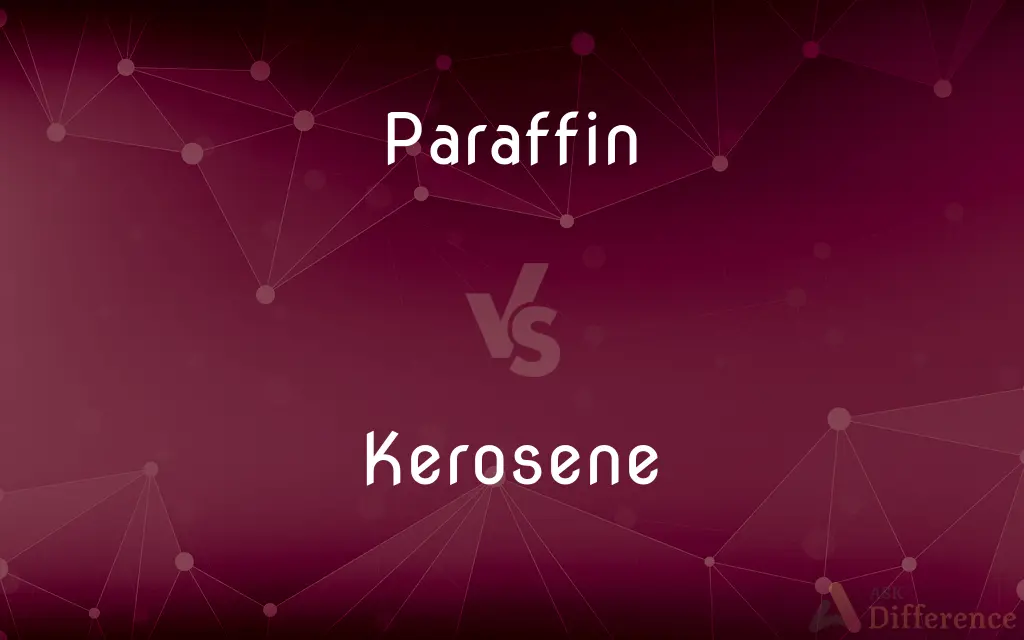Paraffin vs. Kerosene — What's the Difference?
Edited by Tayyaba Rehman — By Fiza Rafique — Updated on September 21, 2023
Paraffin is a white or colorless, soft, waxy substance used in candles and cosmetics. Kerosene is a flammable hydrocarbon liquid commonly used as a fuel.

Difference Between Paraffin and Kerosene
Table of Contents
ADVERTISEMENT
Key Differences
Paraffin is a waxy substance derived from petroleum. It's often used in candles, cosmetics, and for therapeutic treatments in paraffin baths. It's a solid at room temperature and is odorless and colorless, which makes it suitable for a variety of applications in different industries.
Kerosene is a liquid fuel also derived from petroleum, often used for heating and lighting. It's highly flammable and volatile, which makes it a preferred choice for jet fuel and other energy-intensive applications. It has a strong odor and should be handled with care due to its flammable nature.
In terms of their chemical makeup, paraffin is a mixture of heavier alkanes, while kerosene is made up of lighter alkanes. This fundamental chemical difference accounts for their contrasting states at room temperature and their differing volatility. While paraffin is often used in skin treatments and candles, kerosene is used in engines and stoves.
Another notable difference between the two is the safety aspect. Paraffin is generally safe to handle and is not considered hazardous. Kerosene, however, requires more safety precautions like proper ventilation and storage due to its flammable and potentially toxic nature.
Comparison Chart
State at Room Temperature
Solid
Liquid
ADVERTISEMENT
Uses
Candles, cosmetics, therapy
Fuel, lighting, heating
Flammability
Low
High
Chemical Composition
Heavier alkanes
Lighter alkanes
Odor
Odorless
Strong odor
Compare with Definitions
Paraffin
Odorless and colorless.
Paraffin is ideal for making unscented candles.
Kerosene
A flammable hydrocarbon liquid.
Kerosene is commonly used in space heaters.
Paraffin
A waxy solid derived from petroleum.
Paraffin is often used in the production of candles.
Kerosene
Commonly used as jet fuel.
Commercial airlines use a type of kerosene as jet fuel.
Paraffin
Non-volatile and low in flammability.
Paraffin is considered safe for household use.
Kerosene
Strong-smelling and volatile.
Kerosene fumes can be overwhelming if not properly ventilated.
Paraffin
Used in cosmetics and skin treatments.
Paraffin baths are popular for treating dry skin.
Kerosene
Derived from petroleum.
Kerosene is a byproduct of petroleum refining.
Paraffin
Not soluble in water.
Paraffin is hydrophobic and does not dissolve in water.
Kerosene
Used for lighting and heating.
Old lanterns often run on kerosene.
Paraffin
A waxy white or colorless solid hydrocarbon mixture used to make candles, wax paper, lubricants, and sealing materials. Also called paraffin wax.
Kerosene
Kerosene is a combustible hydrocarbon liquid which is derived from petroleum. It is widely used as a fuel in aviation as well as households.
Paraffin
(Chemistry) A member of the alkane series.
Kerosene
A thin oil distilled from petroleum or shale oil, used as a fuel for heating and cooking, in lamps, and as a denaturant for alcohol. Also called coal oil.
Paraffin
Chiefly British Kerosene.
Kerosene
A thin colorless to straw-colored petroleum-based fuel heavier than gasoline/petrol or naptha but lighter than diesel, used primarily as jet fuel but also for heating and lighting in some remote or impoverished areas.
The kerosene lasted all winter, so the furnace kept us always warm.
Paraffin
To saturate, impregnate, or coat with paraffin.
Kerosene
An oil used for illuminating purposes, formerly obtained from the distillation of mineral wax, bituminous shale, etc., and hence called also coal oil. It is now produced in immense quantities, chiefly by the distillation and purification of petroleum. It consists chiefly of several hydrocarbons of the methane series, having from 10 to 16 carbon atoms in each molecule, and having a higher boiling point (175 - 325° C) than gasoline or the petroleum ethers, and a lower boling point than the oils.
Paraffin
(UK) A petroleum-based thin and colourless fuel oil.
Kerosene
A flammable hydrocarbon oil used as fuel in lamps and heaters
Paraffin
(chemistry) Any member of the alkane hydrocarbons.
Paraffin
Paraffin wax.
Paraffin
To impregnate or treat with paraffin.
Paraffin
To embed in paraffin wax.
Paraffin
A white waxy substance, resembling spermaceti, tasteless and odorless, and obtained from coal tar, wood tar, petroleum, etc., by distillation. It is used in candles, as a sealing agent (such as in canning of preserves), as a waterproofing agent, as an illuminant and as a lubricant. It is very inert, not being acted upon by most of the strong chemical reagents. It was formerly regarded as a definite compound, but is now known to be a complex mixture of several higher hydrocarbons of the methane or marsh-gas series; hence, by extension, any substance, whether solid, liquid, or gaseous, of the same chemical series; thus gasoline, coal gas and kerosene consist largely of paraffins.
Paraffin
From crude petroleum; used for candles and for preservative or waterproof coatings
Paraffin
A non-aromatic saturated hydrocarbon with the general formula CnH(2n+2)
Paraffin
British usage
Common Curiosities
Is kerosene safe to inhale?
Kerosene fumes can be harmful and should be properly ventilated.
Are paraffin and kerosene the same?
No, paraffin is solid and used in candles, while kerosene is a liquid fuel.
What is paraffin?
Paraffin is a waxy solid substance derived from petroleum.
Is paraffin flammable?
Paraffin has low flammability compared to kerosene.
What is kerosene used for?
Kerosene is used for heating, lighting, and as jet fuel.
What is kerosene?
Kerosene is a flammable hydrocarbon liquid used primarily as a fuel.
What are the health risks of paraffin?
Paraffin is generally considered safe for external use.
Can I use kerosene in a candle?
No, candles are generally made with waxes like paraffin.
Can I use paraffin in a lamp?
It's not recommended; lamps usually use liquid fuels like kerosene.
Is paraffin edible?
No, paraffin should not be ingested.
Are there different types of paraffin?
Yes, there are varying grades of paraffin used in different industries.
Is kerosene explosive?
While flammable, kerosene is not considered explosive.
Can I use paraffin for cooking?
No, paraffin is not suitable for cooking.
How is kerosene stored?
Kerosene should be stored in a well-ventilated area in approved containers.
Is kerosene a renewable resource?
No, kerosene is a non-renewable petroleum product.
Share Your Discovery

Previous Comparison
Plum vs. Plumb
Next Comparison
Comedy vs. DramaAuthor Spotlight
Written by
Fiza RafiqueFiza Rafique is a skilled content writer at AskDifference.com, where she meticulously refines and enhances written pieces. Drawing from her vast editorial expertise, Fiza ensures clarity, accuracy, and precision in every article. Passionate about language, she continually seeks to elevate the quality of content for readers worldwide.
Edited by
Tayyaba RehmanTayyaba Rehman is a distinguished writer, currently serving as a primary contributor to askdifference.com. As a researcher in semantics and etymology, Tayyaba's passion for the complexity of languages and their distinctions has found a perfect home on the platform. Tayyaba delves into the intricacies of language, distinguishing between commonly confused words and phrases, thereby providing clarity for readers worldwide.
















































